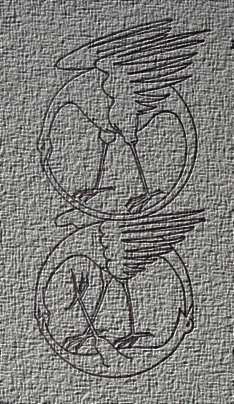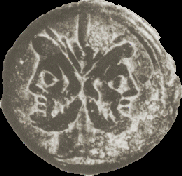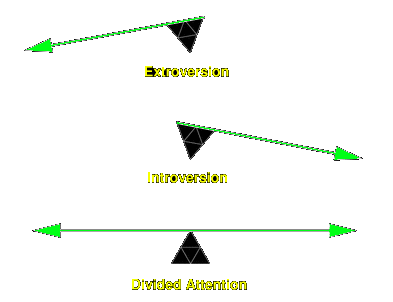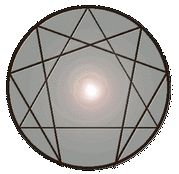




"I don't say it's comfortable, but it's lively."
Rodney Collin, The Theory of Conscious Harmony

In many great teachings, in one form or another, the idea of three worlds is presented. These three "worlds" may be called the body, the soul, and the spirit. The term "body" in this case includes what we normally think of as our body, but it also includes our emotions and thoughts—because our emotions and thoughts are driven by our bodily sensory inputs. It is who and what we are, as we are. It is a miracle, but we have much greater possibilities, and these are our "soul" and our "spirit". And each of these is a much greater miracle than the body.
Practically everything that we do, we do with the body, and with that we are more or less familiar. But we are not familiar with the soul, and we are not familiar with the spirit. It may be said that we lack soul, but it cannot be said that we lack spirit. How can we lack the infinite? What we lack is our connection to the infinite, our connection to spirit, and that connection is the soul.
In some teachings, the world of the soul corresponds to what is called "imagination" (on the fourth way, the term imagination refers instead to uncontrolled mind activity). It is that which "images" the influences of spirit, the inspiration, for presentation to the sense-based body. It may also be called the astral body, the higher emotional center, the ruah (kaballah), and so on. In addition to the different names for the soul between different teachings, it can be confusing because the same term used for soul may be used for our emotional function, just as the same term used for spirit may be used for our intellectual function. This apparent confusion exists because there is a correspondence between the emotions and the soul, and between the intellect and the spirit. In fact, our emotions and intellect may be seen as something like imitations, or images, of the soul and spirit.
An example of this confusion of terminology occurs when we read translations of ancient Greek ideas about "Nous", translated as Mind, or Intellect. Better terms might be Spirit, or Consciousness.
| Basic Functions | Higher Functions |
|---|---|
| Intellect | Higher Mind, "Spirit", Nous |
| Emotions, "Heart" | Higher Emotions, "Soul", Logos |
| Body, physical functions—moving and instinctive functions | Higher Bodies, e.g, "astral", "causal", etc. (See also Fig. 1 in In Search of the Miraculous for a similar but not identical naming scheme.) |
Just as the soul images spirit, so does the emotional function present images to us in dreams. In the latter case, the role of spirit is played by the intellectual part of the emotional center, which seems to draw on instinctive, moving, emotional, and intellectual images to creatively "speak" to us. The intellectual part of the emotional center is our "Shakespeare", and is capable of putting a lot of symbolic meaning into the image plays of our dreams.

Traditionally, the soul is represented as feminine and the spirit as masculine. The soul is seen as passive or receptive to an active function, which may be the body's desires on the one hand or the spirit on the other.
Regarding the soul, in many ancient teachings we come across the idea of the whore and the virgin, and the whore becoming the virgin. Another ancient image is the idea of the bridal chamber, or the marriage of the soul to the spirit.
For example, in gnostic Christianity, we read:
For when the soul leaves her perfect husband because of the treachery of Aphrodite, who exists here in the act of begetting, then she will suffer harm. But if she sighs and repents, she will be restored to her house.
The Exegesis on the Soul, Nag Hammadi Library
The soul's "perfect husband" is the spirit. The soul is distracted or seduced by the world of the body—this is the "treachery of Aphrodite"—but the possibility exists to understand this situation and "repent", to turn the attention of the soul from the body to the spirit.
In the orthodox Christian Gospel of John we find:
But whosoever drinketh of the water that I shall give him shall never thirst; but the water that I shall give him shall be in him a well of water springing up into everlasting life.The woman saith unto him, Sir, give me this water, that I thirst not, neither come hither to draw.
Jesus saith unto her, Go, call thy husband, and come hither.
The woman answered and said, I have no husband.
Jesus said unto her, Thou hast well said, I have no husband: For thou hast had five husbands; and he whom thou now hast is not thy husband: in that saidst thou truly.
The woman at the well is the soul, Jesus is the spirit, and the "five husbands" represent the five senses (mesoteric interpretation), or the five lower functions (esoteric interpretation). Jesus, spirit, is telling the soul to turn her attention from the body to the spirit. The attractions of the body are represented as temporary and ultimately unsatisfying, while with the "water" of the spirit, one will never thirst.
Plato quotes Socrates as saying:
And were we not saying long ago that the soul when using the body as an instrument of perception, that is to say, when using the sense of sight or hearing or some other sense (for the meaning of perceiving through the body is perceiving through the senses)—were we not saying that the soul too is then dragged by the body into the region of the changeable, and wanders and is confused; the world spins round her, and she is like a drunkard when under their influence?But when returning into herself she reflects; then she passes into the realm of purity, and eternity, and immortality, and unchangeableness, which are her kindred, and with them she ever lives, when she is by herself and is not let or hindered; then she ceases from her erring ways, and being in communion with the unchanging is unchanging. And this state of the soul is called wisdom?
Phaedo, Plato [translated by Benjamin Jowett]
Spirit is the unchanging, eternal.
The soul may be represented by the Roman god Janus, the god with two faces, mediating between the world of spirit and the world of body-based sensation:

A more complete image is suggested by the alchemical design shown at the top of this page. The bird on the top, holding its own tail, is complete, self-sufficient, spirit. The two birds at the bottom are the soul and the body. The soul, touching spirit, faces and is connected to the body. The body, faces up toward the soul. This would represent a right relationship of the three worlds in us.

The soul needs to be fed just like the body needs to be fed—the only difference being that the soul feeds on finer matters, higher hydrogens. We take in and refine these matters through divided attention, watching ourself as we perceive the world through our senses (consciously look through your eyes. Try to watch yourself reading this). The energy of attention splits the perceived matter. This is the "division of the atom" for us, the digestion of a certain energy and its consequent refinement. In fact, it is the division of molecules in our blood, the "parting of the red sea". The two-faced Janus is divided attention, the attempt to initiate the activity of the soul.

Self-remembering is a more complete "soul-action": in its full achievement, it is the activity of the soul, monitoring the sensations and receptive to spirit simultaneously.

The soul is our birthright—we are born with it functioning properly, but we lose it, we forget it, we fall asleep. Something has gone wrong, or perhaps a challenge has been set up for our evolution.
Our attention, which is the very matter of the soul, is pulled away from the soul by our identifications. Whether we are identified with external or internal matters, we suffer an imbalance and loss of the stuff of attention unless we are dividing our attention, balancing the work of centers by conscious intent, the proper role of soul.

With the graphic above, I've tried to show something about the imbalance of centers when we are identified. The arrows are something like a vector arrow in physics, showing direction and force, in this case the direction and force of attention. The diagram is simplistic, though, and may even be misleading if taken too literally. The object of our attention is not as significant as whether or not we are aware of ourselves observing it. For example, we can have divided attention on purely internal functions, such as observing our emotional and instinctive centers simultaneously. Similarly, we can divide our attention between externals, maintaining awareness of our hearing and looking simultaneously. And, in higher moments of consciousness, we can be aware of all of these and more. Even just to maintain awareness of, say, ourselves listening to music, requires divided attention, because we will lose our self-awareness unless we continually monitor it. It requires an act of will, and will belongs to the soul.

It may be that language itself originally derives from the communication of spirit in images to the soul, a process properly called inspiration. Words are symbols, and we have seen how symbols mediate between the world of spirit and the world of senses. The classic example of such language is sacred scripture, for example, the Quran of Islam and the Torah of Judaism, which are both seen as the word of God. Such texts are studied at many levels (including the literal interpretation) and it is believed that ever deeper study leads to ever more profound meanings. In short, the language is symbolic, above and beyond the fact of the symbolic nature of language. An example of such interpretation or "exegesis" of scripture is given above in the discussion of the woman at the well in the Gospel of John.
Soul and the emotional center present symbols, or forms, representing something else. The world of spirit may be seen symbolically through the forms of the world by soul. This is when the world becomes alive with meaning, every thing representing something more profound, its "final cause" in the Aristotelian sense.
The enneagram is a symbol that images the three worlds: the circle is the body; the inner circulation of the enneagram—the web-like figure—shows the circulation of the blood; and the triangle is the nervous system. In terms of body, soul and spirit, the circle is the body, the web is "the path of the soul" (as Rodney Collin put it), and the triangle is the spirit.

The nervous system speaks to our body through the endocrine gland secretions in our blood. We tend to be more aware of this when the hormones in question are such obvious ones as testosterone or adrenaline, and less aware of the more subtle secretions of of the anterior pituitary which controls these other secretions. The anterior pituitary in turn is controlled by the nervous system, being in immediate contact with the hypothalamus, a portion of the human brain. Balanced functioning requires intentional control of the nervous system, and therefore leads to control of the endocrine system. This process of acquiring control of the contents of the bloodstream by intentional behavior is analogous to, and a precursor of, control of the soul by the spirit.

We can look at the three worlds "cosmogonically", that is, in respect to the creation. Take the opening of the Gospel of John:
In the beginning was the Word, and the Word was with God, and the Word was God. The same was in the beginning with God. All things were made by him, and without him was not anything made that was made.
Here we have the three worlds: the world of spirit (God), the world of body (things), and the world of the soul (Word). When we view the creation as God -> Word -> things, (spirit -> soul -> matter) we can see how the idea of "Maya" arises. The middle world, the world of soul, represents the world of spirit through images. On the scale of creation, these images are the world we see.
All things are metaphors.
Goethe
Seen as the living Word, these images are windows to the spirit. Seen as self-existing things, the images are dead matter.
One of the characteristics of the world of spirit is meaning, and it is meaning that is communicated by images: images that we are able to assimilate for better or worse, until we can see in the world of spirit directly.

Now. To return to practical ideas of the fourth way. Spirit is higher intellectual center ("this system comes from higher mind"), soul is higher emotional center, and body is our ordinary state. To grow spiritually, we need to have a soul that transmits spirit, through soul, to even us here in the body. And we need to be able to understand the images that are transmitted. Our soul is the missing link in conscious evolution.
"And so it is written, The first man Adam was made a living soul; the last Adam was made a quickening spirit."
1 Corinthians 45
According to some, we do not have a soul and have to create one. Others say we have a soul but it is asleep, or nascent. Regardless, we have to know what to "do". People with a superficial knowledge of the fourth way say "we cannot do". While this is true regarding many of the abilities we ascribe to ourself, the whole idea of the fourth way is to find out exactly those areas in which we can "do", and work on them.
The work of the fourth way is precisely to activate the soul. The soul requires finer matters, finer energies, which are produced from the same foods that our body requires. We need to both produce more of these matters and reduce the waste of those we do produce. This practice of refining and increasing matters is sometimes called "alchemy".
All of the practical ideas of the fourth way are practical alchemy. We try to remember ourselves, externally consider, observe ourselves, find reasons for not expressing negative emotions, struggle with identification, and so on, to increase and conserve finer "hydrogens".
If we are able to increase our finer energies, we begin to quicken our soul. This is naturally an uncomfortable process, at least as long as we are full of wrong working of functions as we are, but this discomfort is the friction that produces the very energy that enables us to see the wrong work and struggle with it.
And these in truth are the so-called trials, which the sacred stories say Hercules underwent and any other hero who valiantly strives for freedom, until they succeed in raising up the spirit [soul] to a height where the hands of nature cannot reach it.On Visions, Synesius [Mead translation]
We need to vibrate at a much higher rate to resonate with higher influences. A higher rate of vibration resolves lower functions into a harmony, much as a small enough divisor in arithmetic may relate different numbers. This higher rate of vibration is nothing less than inner life, and is the chief difference between people on Earth. It separates the quick from the dead.
"Perhaps our mistake is that we want peace in the wrong place. People ask for peace in their souls—they should ask for turmoil in their souls, so that they may find real peace in their spirits."The Theory of Conscious Harmony, Rodney Collin
The neo-Platonic tradition, for one, emphasizes that the soul is characterized by motion. Spirit is timeless, so motion does not apply, and body is essentially inert, animated only by soul. Soul is itself moved in one of two ways. In one of its motions, the soul is moved by externals—it is controlled from without. We simply react, as machines. In this case the soul is manipulated, used, and such a condition corresponds to the "whore" of certain teachings. But in the second case, the soul is self-motive, the soul controls and sustains its own motion. It is controlled by our will in order to look toward the spirit. This is the "virgin". (These two motions of the soul may be expressed in another way by the two "great triads" as discussed in The Six Processes.)
With the knowledge from the neo-Platonic tradtion, then, we are able to resolve an apparent contradiction in fourth way teachings in which the soul is said sometimes to be asleep, at other times is said to not exist. The soul is asleep in the sense it is not will-ing; it does not exist in the sense that the true motion of the soul, self-motion, is lacking. The two motions of the soul are in opposite directions, and the change in direction of the motion of the soul, from accidental to willed, is termed "metanoia" in the Greek, or "repentance" in esoteric Christianity.

We work directly on creating or energizing our soul with our nervous system. By an act of will, we both resist the external forces that do with our soul what they will and try instead to will a new, intended, motion. We call this "attempting to self-remember". This effort introduces consciousness to our functioning. Remember that consciousness varies in three ways: by frequency, duration, and depth. Frequency is how often we try to remember ourselves, duration is for how long we are able to maintain self-remembering, and depth is the penetration of this self awareness, the extent to which we are aware of ourselves in our surroundings. In higher consciousness, these three variations merge to become one self-sustained state. We have the necessary information to begin work on our souls.
All pages Copyright ©John Raithel